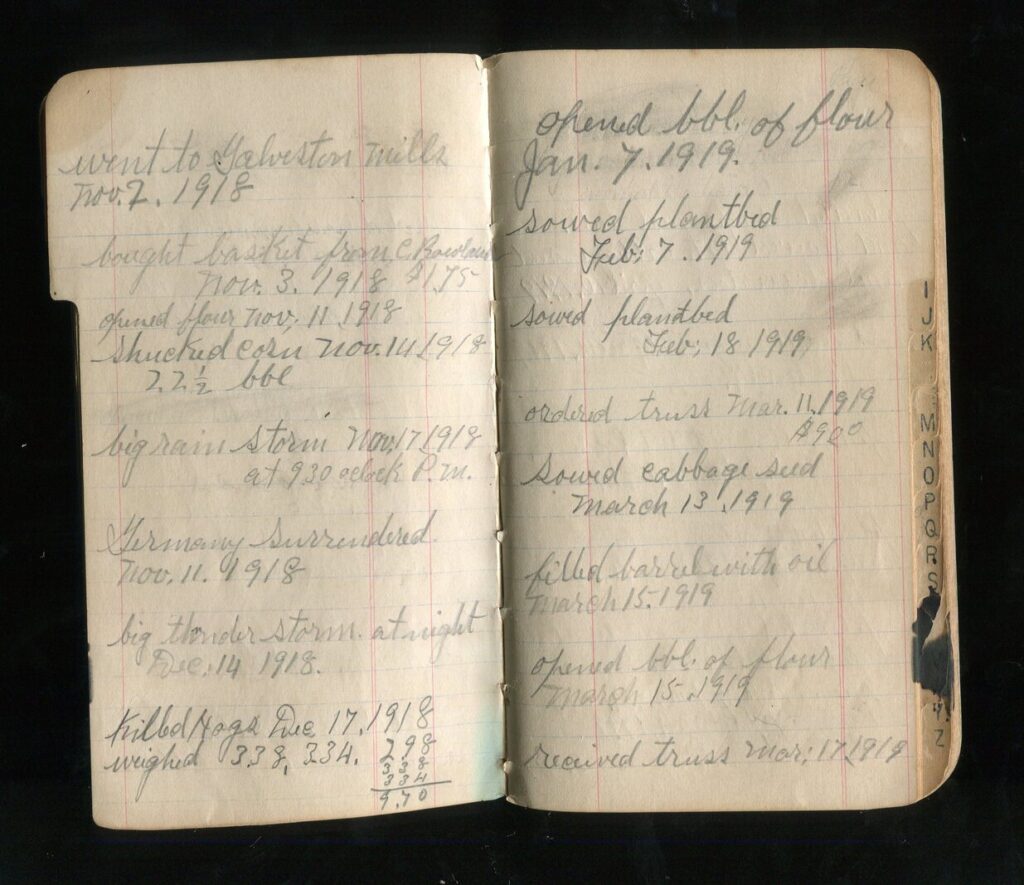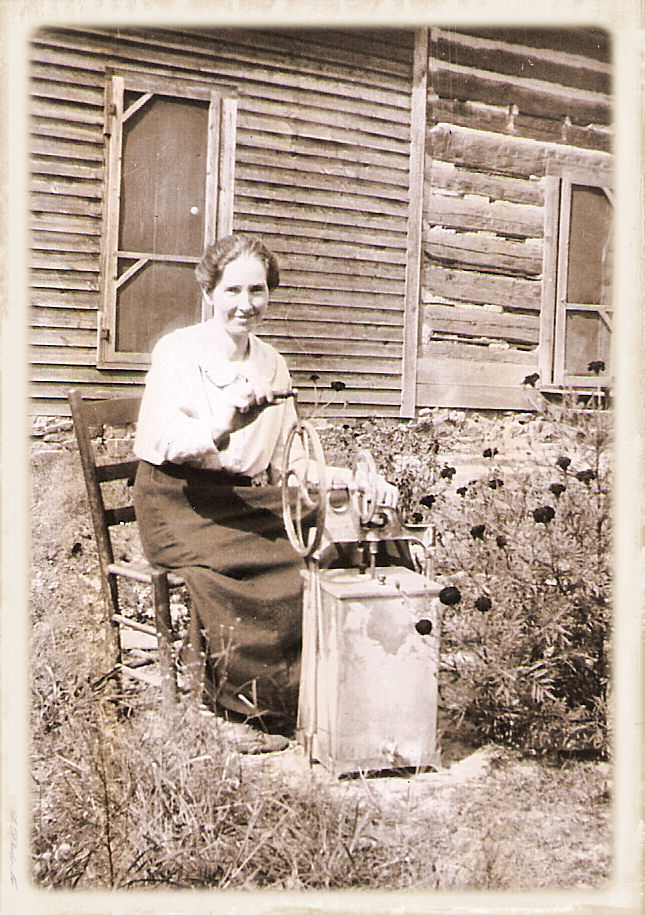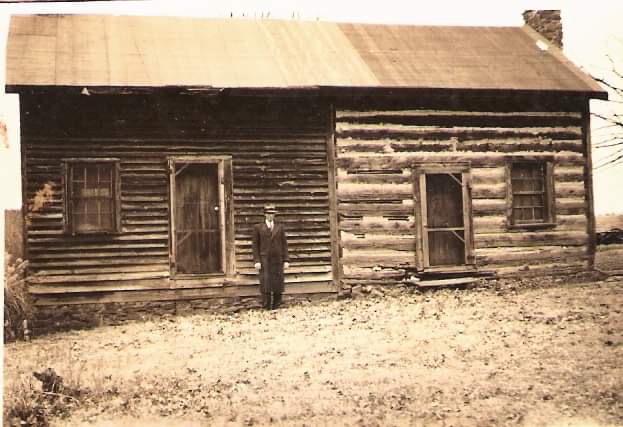
**This research was first published in the April 10, 2024 edition of the Chatham Star-Tribune newspaper as part of Kyle Griffith’s weekly segment entitled “Heritage Highlights.”
James Monroe Woodson (1880-1970) and his wife Laura Ellen Rowland Woodson (1887-1963).
She is seen using a tall metal Dazey Churn to make butter outdoors.
Photos courtesy of Michael Barbour, a relative.
Historic journals can be captivating resources for learning about the past. It has been my recent undertaking to transcribe the journal of a local tobacco farmer James Monroe Woodson (1880-1970). He lived on Chalk Level Road near the junction of Hurt Road. Together, he and his wife, Laura Ellen Rowland (1887-1963) raised five children. As a farmer, Woodson kept a farm journal to remember when he planted certain crops, the quantity, business transactions, weather, and otherwise notable events. This primary source provides valuable insight into the endeavors and annual duties shared by tobacco farming families across the Virginia Piedmont region.
The journal begins with the entry “Carried cow to Jim Rowland’s August 16, 1917.” The first presence of frost appeared on Oct. 7, and the following day Woodson paid a visit to Galveston Mill to have his wheat ground to flour. Two big frosts occurred over the following week before ultimately one of the most destructive natural events in the county took place. He noted rather casually, “cyclone at Gretna Oct. 29, 1917.” In reality, this horrific storm destroyed several dwellings, businesses, and a church in town. Several people were thrown from their homes and the event resulted in the death of a three-month-old baby.
The following month, Woodson ordered pigs on Nov. 19 and Dec. 14 was hog-killing time. Two hogs weighed a combined 770 lbs and the smokehouse was packed for winter. In February 1918, he purchased two barrels of flour at B. R. Powell’s department store for $25. This is notable since Powell’s store was ruined by the recent cyclone, but had reopened in a nearby building. Woodson was diligent in recording when he opened a new flour barrel. According to the entries, a barrel lasted two months for this family of six (and one on the way).
The old fashioned farmhouse of J. M. Woodson & family, part log construction. Photo courtesy of Michael Barbour.
On Feb. 16 and 26 he sowed a plant bed for his tobacco. He planted three rows of onions, then snap peas and cabbages throughout March and April. A week later, five inches of snow fell and surely affected the garden. Woodson “put out a hot bed” to combat the weather. In May, he sowed cabbage seed, planted Irish potatoes, snaps, beans, and corn. Woodson’s nonchalant entry about the birth of his son, Hyrum, simply reads, “Baby May 13, 1918.” Toward the end of May, it was time to transplant tobacco. Over the following two weeks he planted over 25,000 hills of tobacco. All the hours of toil are evident in his brief entries: “Planted 4,000 tob. June 5, 1918…Planted 4,400 tob. June 6…Planted 5,000 tob. June 7…Planted 1,350 tob. June 8…”
As the sweltering heat of July rolled around, Woodson sowed two acres of peas. He thrashed 66 ½ bushels of wheat and hauled it to the wheat mill six days later. He sowed a turnip patch on July 23 and then sawed wood the following week. Journal entries were scarce until October, when he sowed oats and vetch for the hogs. At the end of the month he sowed 5 ¼ acres of wheat in one day and an additional 2 ½ the next day. He then made a purchase of 35 lbs of beef from his cousin Frank Irby for seven dollars. Soon after, Woodson purchased a basket from Coleman Rowland (a relative of his wife) for $1.75. He visited Galveston Mill once more in November to make flour. In broader terms of history, Woodson documented the end of the Great War in one brief note that stated “Germany surrendered Nov. 11, 1918.” Life continued on the farm, and more than 22 barrels of corn shuckings were produced by Nov. 14. The last few chilly weeks of the year conjured big storms during the nighttime. The final project of 1918 involved the customary hog-killing time. The three hogs of choice weighed 338 lbs, 334 lbs, and 298 lbs, for a total of 970 lbs.
Woodson’s journal continued in a similar fashion until 1924, when entries became more brief and recorded only weather data between 1925-1928. Many decades later, the farm journal ended up in an antique store. Local historian Bobby Ricketts found it there, purchased it, and it has recently changed hands to my collection. It was not obvious who wrote the journal, but after a bit of investigation and genealogy research, I discerned the journal to be written by Woodson.
The journal is about 6 in tall and 4.5 in wide. The cover, which is detached, is a brown checkered pattern. Despite the wear on the cover, the pages remain in good condition with easily legible writing. Some of the entries are not in chronological order, but the accompanying bullet point transcriptions are in order.


- Carried cow to Jim Rowland’s August 16, 1917
- Sowed Turnip patch Sept. 8, 1917
- Covered cook room Sept 18, 1917
- Rain Storm Oct 5, 1917
- First frost Oct 7, 1917
- Went to Galveston Mill Oct 8, 1917
- Dug potatoes Oct 10, 1917
- Big Frost Oct 13, 1917
- Sowed 3 acres wheat Oct 13, 1917
- Big Frost Oct 14, 1917
- Sowed 2 acres wheat Oct. 15, 1917
- Sowed 1 acre wheat Oct. 16, 1917
- Sowed 2 ¼ acres wheat Oct. 18, 1917
- Cyclone at Gretna Oct 29, 1917
- Returned coat to Charles W. Nov 19, 1917
- Ordered pigs Nov 19, 1917
- Shucked Corn Nov 27, 1917
- Killed hogs Dec 14, 1917 weighed 380+390=770
- Bought 2 bbls. Flour at Powell’s Feb 7, 1918 $25.00
- Bought basket from Coleman Rowland Feb 10, 1918 $1.50
- Opened barrel of flour Feb 13, 1918
- Sowed plant bed Feb 16, 1918
- Went to Danville Feb 19, 1918
- Sowed plant bed Feb 26, 1918
- Had Dr. Owen to see Delsie March 2, 1918 $2.50
- Planted onions March 2, 1918 three rows
- Planted snaps & cabbages April 2, 1918
- Big rain April 9-10 big snow
- April 11 5in deep 1918
- Put out hot bed April 17, 1918
- Sowed cabbage seed May 4, 1918
- Planted Irish potatoes May 9, 1918
- Planted snaps & b. Beans May 10, 1918
- Planted corn on road to corner May 11, 1918
- Planted corn May 13, 1918
- Baby May 13, 1918 [Hyrum Lloyd Woodson]
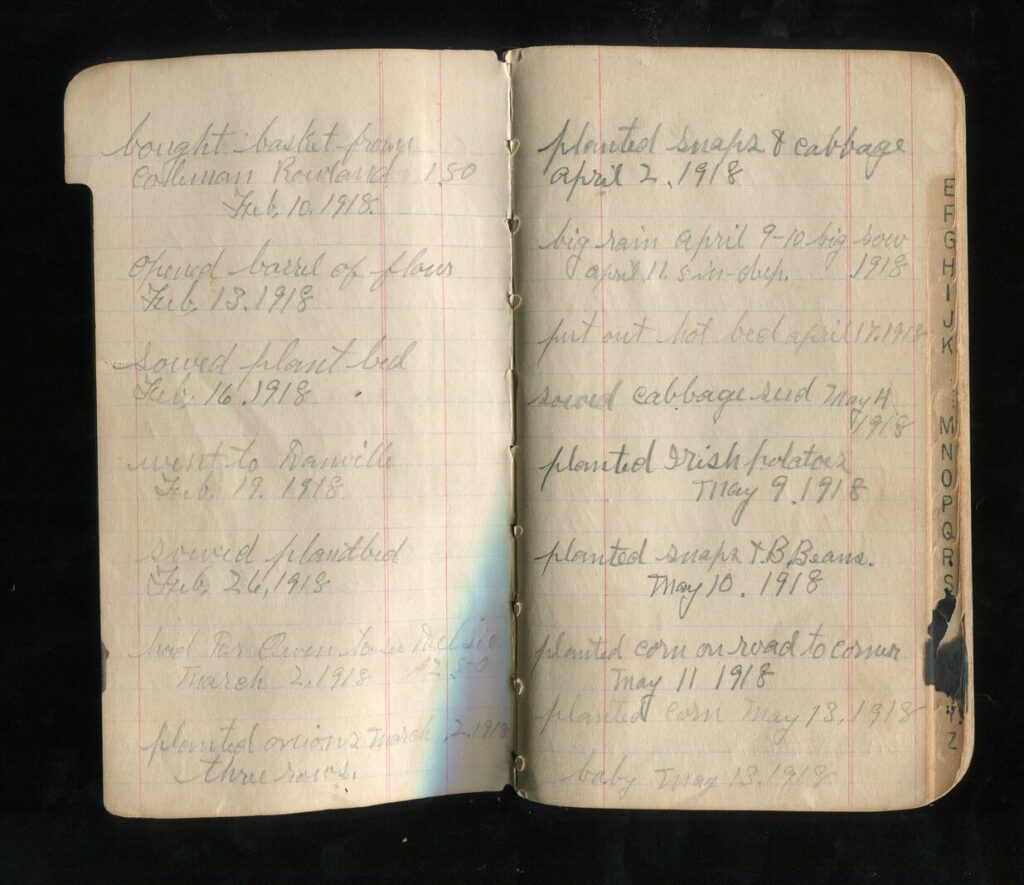
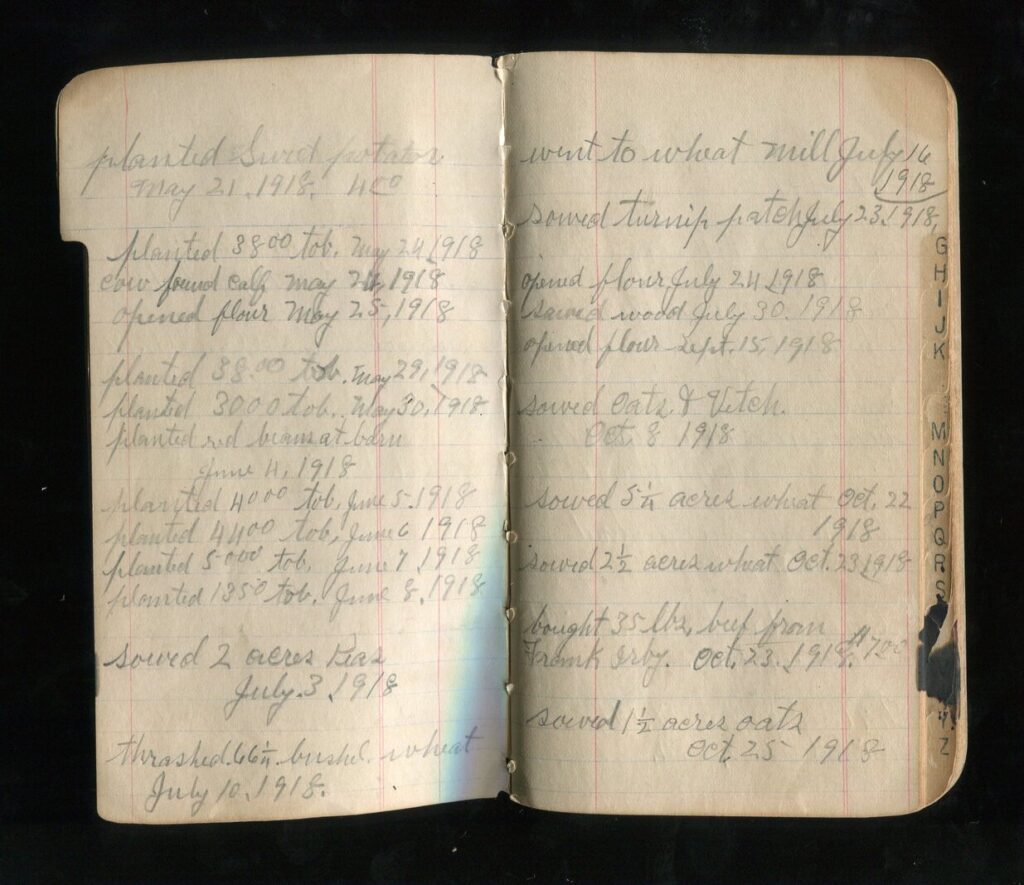
- Planted sweet potatoes May 21, 1918 $4.00
- Planted 3800 tob. May 24 1918
- Cow found calf May 24, 1918
- Opened flour May 25, 1918
- Planted 3800 tob. May 29, 1918
- Planted 3000 tob. May 30, 1918
- Planted red beans at barn June 4, 1918
- Planted 4000 tob. June 5, 1918
- Planted 4400 tob. June 6, 1918
- Planted 5000 tob. June 7, 1918
- Planted 1350 tob. June 8, 1918
- Sowed 2 acres peas July 3, 1918
- Thrashed 66 ¼ bushel wheat July 10, 1918
- Went to wheat mill July 16, 1918
- Sowed turnip patch July 23, 1918
- Opened flour July 24, 1918
- Sawed wood July 30, 1918
- Opened flour Sept 15, 1918
- Sowed oats & vetch Oct 8, 1918
- Sowed 5 ¼ acres wheat Oct. 22, 1918
- Sowed 2 ½ acres wheat Oct. 23, 1918
- Bought 35lbs beef from Frank Irby Oct. 23, 1918 $7.00
- Sowed 1 ½ acres oats Oct 25, 1918
- Went to Galveston Mills Nov 2, 1918
- Bought basket from C. Rowland Nov 3, 1918 $1.75
- Opened flour Nov 11, 1918
- Germany Surrendered Nov. 11, 1918
- Shucked corn Nov 14, 1918 22 ½ bbl
- Big rain storm Nov 17, 1918 at 9:30 oclock P.M.
- Big thunderstorm at night Dec 14, 1918
- Killed hogs Dec 17, 1918 weighed 338+334+298=970
